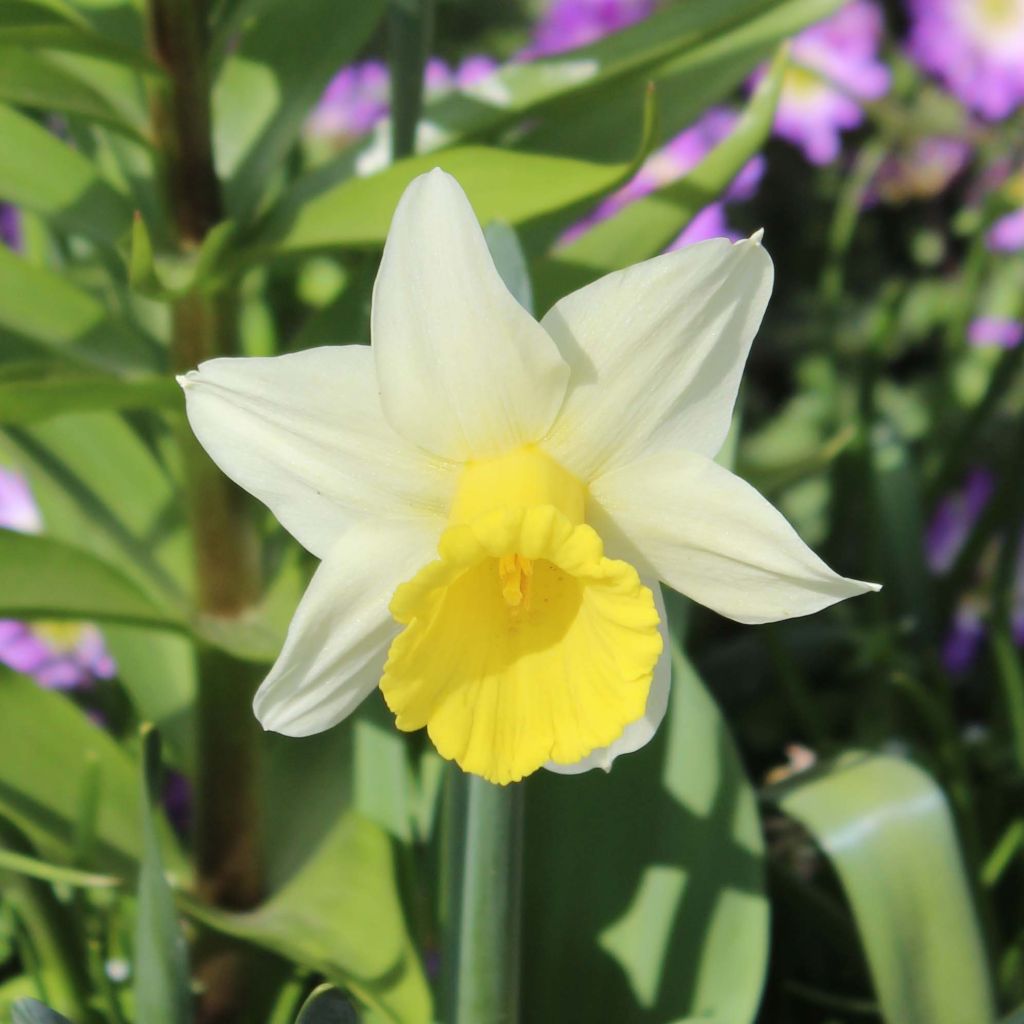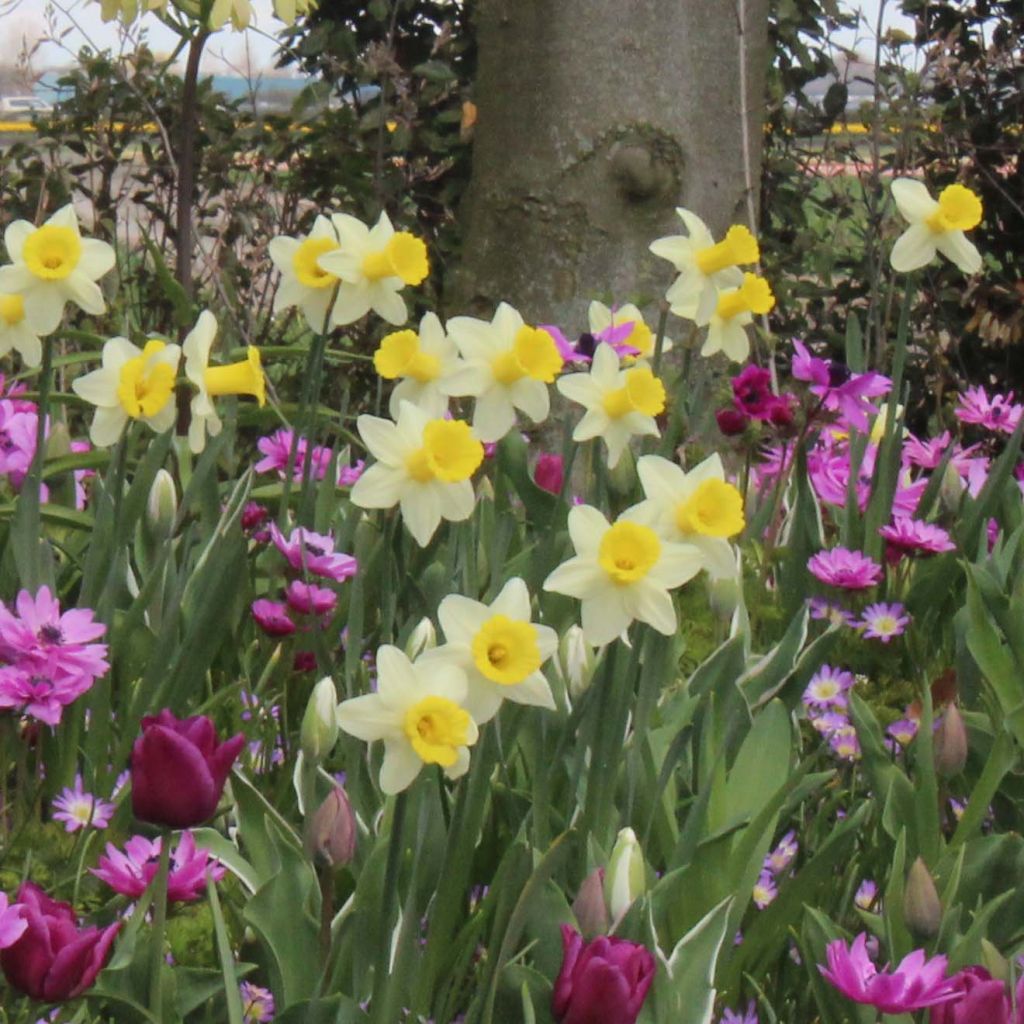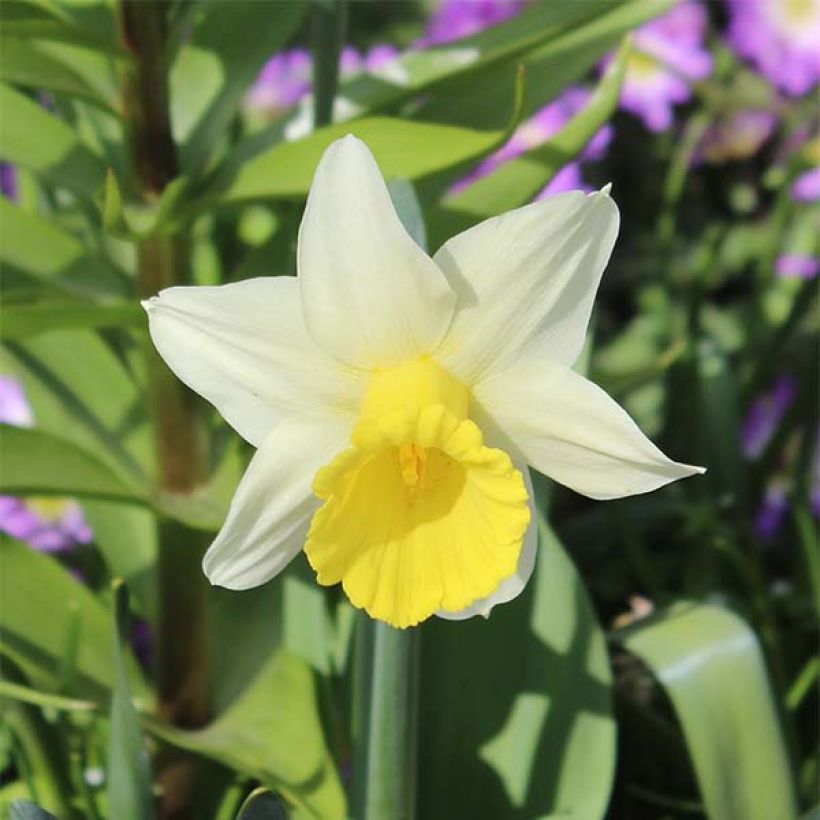

Narcisse Peeping Jenny


Narcisse Peeping Jenny
Narcissus cyclamineus Peeping Jenny
Narcissus cyclamineus Peeping Jenny
Daffodil 'Peeping Jenny'
Neck package, perfect and ready to plant.
Catherine V., 14/10/2018
This plant carries a 6 months recovery warranty
More information
We guarantee the quality of our plants for a full growing cycle, and will replace at our expense any plant that fails to recover under normal climatic and planting conditions.
From €5.90 for pickup delivery and €6.90 for home delivery
Express home delivery from €8.90.

Does this plant fit my garden?
Set up your Plantfit profile →
Description
Narcissus 'Peeping Jenny' produces flowers with yellow petals that turn creamy-white during flowering. These flowers have a long, trumpet-shaped yellow crown in the centre. It will reach a height of approximately 35cm (14in). This narcissus is an easy-to-grow and hardy bulbous plant, quietly settling in the garden. Bulbs should be planted in autumn for flowering in March.
Native to Western Europe, the narcissus belongs to the Amaryllidaceae family. The narcissus genus includes numerous species and varieties, both botanical and horticultural in origin. Narcissus jonquilla, with yellow flowers and rush-like leaves, is one of the species in the Narcissus genus. In certain regions, the yellow narcissus or trumpet narcissus (Narcissus pseudonarcissus) is sometimes called daffodil, which often leads to confusion between daffodils and narcissus.
The narcissus is a bulbous plant with slightly pointed linear leaves, which are green or sometimes slightly bluish in colour. The hollow stems end in single or double flowers, with 6 white or yellow petals. A crown in shades of yellow or orange often sits in the centre. Belonging to the Cyclamineus Narcissus group, 'Peeping Jenny' has flowers that lean forward, with petals slightly curved backward. The petals of this variety are yellow when the flowers first bloom and then turn white during the flowering period. The flowers have a long, trumpet-shaped yellow crown in the centre.
Narcissus flowers bloom for about fifteen days. Flowering occurs between February and May, depending on the variety. 'Peeping Jenny' blooms in March. These flowers are perfect for bouquets, as long as they are not mixed with other flowers, as the sap releases a substance that accelerates wilting.
Daffodils are easy to grow. They can be planted at the forefront of a shrub bed, along a border, in the middle of a lawn, or in a pot. It pairs beautifully with muscari, early tulips, and hyacinths. The bulbs easily naturalise. However, be aware that the bulb, flower, and leaves are toxic. This deciduous bulbous plant is hardy and perennial, with bulbs able to remain in the ground for several years.
Report an error about the product description
Narcissus cyclamineus Peeping Jenny in pictures




Plant habit
Flowering
Foliage
Botanical data
Narcissus
cyclamineus
Peeping Jenny
Amaryllidaceae
Daffodil 'Peeping Jenny'
Cultivar or hybrid
Planting and care
Daffodils are not demanding when it comes to soil type. They thrive in ordinary soils that are preferably moist and fertile. Plant the bulbs in a sunny or semi-shady location. To stagger the flowering, plant them in several locations, varying in sunlight exposure, as daffodils flower depending on the amount of sunlight.
Plant from September to November for spring flowering. Plant the bulbs at a depth of 15cm (6in), with the pointed end facing upwards, while maintaining a spacing of 8cm (3in). You can plant them in groups of 5 to 10 bulbs to achieve a beautiful colour effect in spring.
Daffodils require little maintenance. Remove the faded flowers to prevent the bulb weakening from seed production. After flowering, let the foliage naturally wither and only cut it when it turns yellow. The bulbs use the foliage to replenish their reserves.
Daffodils can remain in place from one year to the next. If the clumps become dense and less floriferous, gently remove them when the foliage is dry and divide them before immediately replanting them.
Planting period
Intended location
Care
-
, onOrder confirmed
Reply from on Promesse de fleurs
Haven't found what you were looking for?
Hardiness is the lowest winter temperature a plant can endure without suffering serious damage or even dying. However, hardiness is affected by location (a sheltered area, such as a patio), protection (winter cover) and soil type (hardiness is improved by well-drained soil).

Photo Sharing Terms & Conditions
In order to encourage gardeners to interact and share their experiences, Promesse de fleurs offers various media enabling content to be uploaded onto its Site - in particular via the ‘Photo sharing’ module.
The User agrees to refrain from:
- Posting any content that is illegal, prejudicial, insulting, racist, inciteful to hatred, revisionist, contrary to public decency, that infringes on privacy or on the privacy rights of third parties, in particular the publicity rights of persons and goods, intellectual property rights, or the right to privacy.
- Submitting content on behalf of a third party;
- Impersonate the identity of a third party and/or publish any personal information about a third party;
In general, the User undertakes to refrain from any unethical behaviour.
All Content (in particular text, comments, files, images, photos, videos, creative works, etc.), which may be subject to property or intellectual property rights, image or other private rights, shall remain the property of the User, subject to the limited rights granted by the terms of the licence granted by Promesse de fleurs as stated below. Users are at liberty to publish or not to publish such Content on the Site, notably via the ‘Photo Sharing’ facility, and accept that this Content shall be made public and freely accessible, notably on the Internet.
Users further acknowledge, undertake to have ,and guarantee that they hold all necessary rights and permissions to publish such material on the Site, in particular with regard to the legislation in force pertaining to any privacy, property, intellectual property, image, or contractual rights, or rights of any other nature. By publishing such Content on the Site, Users acknowledge accepting full liability as publishers of the Content within the meaning of the law, and grant Promesse de fleurs, free of charge, an inclusive, worldwide licence for the said Content for the entire duration of its publication, including all reproduction, representation, up/downloading, displaying, performing, transmission, and storage rights.
Users also grant permission for their name to be linked to the Content and accept that this link may not always be made available.
By engaging in posting material, Users consent to their Content becoming automatically accessible on the Internet, in particular on other sites and/or blogs and/or web pages of the Promesse de fleurs site, including in particular social pages and the Promesse de fleurs catalogue.
Users may secure the removal of entrusted content free of charge by issuing a simple request via our contact form.
The flowering period indicated on our website applies to countries and regions located in USDA zone 8 (France, the United Kingdom, Ireland, the Netherlands, etc.)
It will vary according to where you live:
- In zones 9 to 10 (Italy, Spain, Greece, etc.), flowering will occur about 2 to 4 weeks earlier.
- In zones 6 to 7 (Germany, Poland, Slovenia, and lower mountainous regions), flowering will be delayed by 2 to 3 weeks.
- In zone 5 (Central Europe, Scandinavia), blooming will be delayed by 3 to 5 weeks.
In temperate climates, pruning of spring-flowering shrubs (forsythia, spireas, etc.) should be done just after flowering.
Pruning of summer-flowering shrubs (Indian Lilac, Perovskia, etc.) can be done in winter or spring.
In cold regions as well as with frost-sensitive plants, avoid pruning too early when severe frosts may still occur.
The planting period indicated on our website applies to countries and regions located in USDA zone 8 (France, United Kingdom, Ireland, Netherlands).
It will vary according to where you live:
- In Mediterranean zones (Marseille, Madrid, Milan, etc.), autumn and winter are the best planting periods.
- In continental zones (Strasbourg, Munich, Vienna, etc.), delay planting by 2 to 3 weeks in spring and bring it forward by 2 to 4 weeks in autumn.
- In mountainous regions (the Alps, Pyrenees, Carpathians, etc.), it is best to plant in late spring (May-June) or late summer (August-September).
The harvesting period indicated on our website applies to countries and regions in USDA zone 8 (France, England, Ireland, the Netherlands).
In colder areas (Scandinavia, Poland, Austria...) fruit and vegetable harvests are likely to be delayed by 3-4 weeks.
In warmer areas (Italy, Spain, Greece, etc.), harvesting will probably take place earlier, depending on weather conditions.
The sowing periods indicated on our website apply to countries and regions within USDA Zone 8 (France, UK, Ireland, Netherlands).
In colder areas (Scandinavia, Poland, Austria...), delay any outdoor sowing by 3-4 weeks, or sow under glass.
In warmer climes (Italy, Spain, Greece, etc.), bring outdoor sowing forward by a few weeks.


































